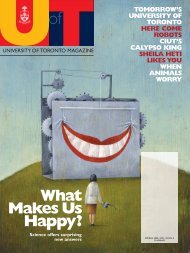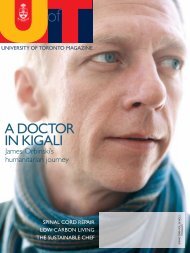What's the solution to Toronto's traffic problems? - University of ...
What's the solution to Toronto's traffic problems? - University of ...
What's the solution to Toronto's traffic problems? - University of ...
You also want an ePaper? Increase the reach of your titles
YUMPU automatically turns print PDFs into web optimized ePapers that Google loves.
OR YEARS, JIM YATES, A VETERAN LOBLAWS EXECUTIVE, had<br />
an almost effortless trip <strong>to</strong> work: just 20 minutes from<br />
his west-end home <strong>to</strong> <strong>the</strong> food giant’s mid<strong>to</strong>wn head<br />
<strong>of</strong>fice. He usually drove, but in good wea<strong>the</strong>r he <strong>of</strong>ten<br />
rode his bike. All that changed when his department moved<br />
in<strong>to</strong> <strong>the</strong> company’s new corporate complex in Bramp<strong>to</strong>n.<br />
Now, says Yates, he leaves his home an hour earlier and has<br />
<strong>to</strong> drive at least an hour each way. Poor wea<strong>the</strong>r and dense<br />
afternoon <strong>traffic</strong> can draw out <strong>the</strong> return trip <strong>to</strong> well over 90<br />
minutes. He tries <strong>to</strong> makes productive use <strong>of</strong> <strong>the</strong> time but<br />
acknowledges that <strong>the</strong> journeys take <strong>the</strong>ir <strong>to</strong>ll: “It’s way more<br />
tiring,” he says.<br />
Yates, <strong>of</strong> course, is not alone; just <strong>the</strong> opposite, in fact.<br />
Across <strong>the</strong> Greater Toron<strong>to</strong> Area, hundreds <strong>of</strong> thousands <strong>of</strong><br />
commuters take <strong>to</strong> <strong>the</strong> region’s highways every day because<br />
<strong>the</strong>y feel public transit is not an option for <strong>the</strong>m. The situation<br />
inside <strong>the</strong> city proper isn’t much better. Encumbered by<br />
decades <strong>of</strong> under-investment, <strong>the</strong> Toron<strong>to</strong> Transit Commission’s<br />
subway network is woefully small and increasingly<br />
overcrowded.<br />
Governments have begun <strong>to</strong> take heed, committing billions<br />
<strong>to</strong> extending <strong>the</strong> Spadina subway <strong>to</strong> Vaughan, expanding<br />
GO Transit service and building four new light-rapid transit<br />
(LRT) routes <strong>to</strong> connect Toron<strong>to</strong>’s inner suburbs. Those four<br />
lines, which will cost Queen’s Park $8.4 billion, were approved<br />
following a gut-wrenching fight at Toron<strong>to</strong> City Hall this<br />
spring. That showdown pitted Mayor Rob Ford, an ardent<br />
proponent <strong>of</strong> subways, against a broad coalition <strong>of</strong> city councillors<br />
who argued that <strong>the</strong> city’s inner suburbs didn’t have<br />
<strong>the</strong> population <strong>to</strong> justify <strong>the</strong> huge cost. Ford lost.<br />
While <strong>the</strong>se investments represent <strong>the</strong> largest expansion<br />
<strong>of</strong> rapid transit in Toron<strong>to</strong> in more than a generation, <strong>to</strong>ugh<br />
questions remain – especially for commuters who live<br />
and work in <strong>the</strong> outer suburbs. Gridlock costs <strong>the</strong> region an<br />
estimated $6 billion a year in lost productivity. Toron<strong>to</strong>’s air<br />
quality, though improved in recent years, continues <strong>to</strong> suffer<br />
because <strong>of</strong> excess smog. And with average commute times<br />
now in <strong>the</strong> 80-minute range, travelling across <strong>the</strong> GTA is<br />
a daunting task – one that will only become worse as three<br />
million people settle in <strong>the</strong> region over <strong>the</strong> next two decades.<br />
As a new Pembina Institute survey found, two-thirds <strong>of</strong><br />
drivers experience stress on <strong>the</strong>ir daily odyssey. “Until transit<br />
becomes a convenient <strong>solution</strong> in <strong>the</strong> entire region,” says<br />
U <strong>of</strong> T geographer André Sorensen, who studies land use in<br />
<strong>the</strong> GTA, “we’re not going <strong>to</strong> solve our congestion <strong>problems</strong>.<br />
That’s <strong>the</strong> dilemma.”<br />
To correct that deficit, Metrolinx, <strong>the</strong> regional transportation<br />
agency established in 2006, has developed a $50-billion,<br />
25-year strategy known as “The Big Move” <strong>to</strong> build a network<br />
<strong>of</strong> high-occupancy vehicle lanes, LRT lines, bus rapid transit<br />
corridors, and subways in <strong>the</strong> GTA and Hamil<strong>to</strong>n. It also<br />
wants <strong>to</strong> transform GO rail from a rush-hour service focused<br />
on getting commuters <strong>to</strong> Union Station in <strong>the</strong> morning and<br />
back home <strong>to</strong> <strong>the</strong> suburbs after work in<strong>to</strong> a system that can be<br />
used all day, in any direction. But <strong>the</strong> agency and its Liberal<br />
masters have yet <strong>to</strong> reveal <strong>to</strong> voters how <strong>the</strong>y plan <strong>to</strong> pay for<br />
all <strong>the</strong>se transit projects. What’s more, some critics wonder<br />
whe<strong>the</strong>r Metrolinx’s plan will deliver <strong>the</strong> goods or merely dent<br />
<strong>the</strong> GTA’s grinding commute times. This much is clear: <strong>the</strong><br />
region is now in <strong>the</strong> thick <strong>of</strong> an his<strong>to</strong>ric debate about its own<br />
future. The LRT train, it would seem, has left <strong>the</strong> station.<br />
ob Prichard, by his own account, has had <strong>the</strong> good<br />
fortune <strong>to</strong> spend much <strong>of</strong> his career perched a<strong>to</strong>p<br />
three institutions with uniquely expansive perspectives<br />
on <strong>the</strong> city: U <strong>of</strong> T (as president), <strong>the</strong> Toron<strong>to</strong> Star (he ran<br />
Torstar), and now Metrolinx. Three years ago, when Ontario<br />
Premier Dal<strong>to</strong>n McGuinty tapped him <strong>to</strong> serve as chair <strong>of</strong> <strong>the</strong><br />
new regional transportation agency, <strong>the</strong> 63-year-old former<br />
law school dean agreed because McGuinty assured him that<br />
<strong>the</strong> GTA’s gridlock problem was high on his <strong>to</strong>-do list.<br />
The urban file was hardly new <strong>to</strong> Prichard: in 1995, he sat on<br />
Anne Golden’s Greater Toron<strong>to</strong> Taskforce, which anticipated<br />
<strong>the</strong> region’s hyper-growth and recommended a regional<br />
council <strong>to</strong> help manage, among o<strong>the</strong>r things, mounting<br />
transportation-related <strong>problems</strong>. Seventeen years later,<br />
<strong>the</strong> heightened public interest in transit is great news, says<br />
Prichard. “We have <strong>to</strong> seize that moment.”<br />
As Prichard well knows, Metrolinx’s most formidable<br />
challenge is figuring out how <strong>to</strong> deliver transit in <strong>the</strong> City <strong>of</strong><br />
Toron<strong>to</strong>’s rapidly growing suburbs where sprawling development<br />
has militated against efficient and convenient transit<br />
service. Indeed, <strong>the</strong> Canadian Urban Institute recently<br />
reported that <strong>the</strong> GTA now contains more than 200 million<br />
square feet <strong>of</strong> <strong>of</strong>fice space, making it one <strong>of</strong> just four such<br />
regions in North America. Thirty years ago, almost two-thirds<br />
<strong>of</strong> <strong>the</strong> GTA’s <strong>of</strong>fices were on subway lines. By 2010, however,<br />
less than half <strong>of</strong> region’s <strong>of</strong>fice space was anywhere near a<br />
rapid transit s<strong>to</strong>p.<br />
GO Transit has certainly ameliorated <strong>the</strong> tidal wave <strong>of</strong> <strong>traffic</strong>.<br />
The system <strong>of</strong> buses and trains serving communities outside<br />
<strong>of</strong> Toron<strong>to</strong> now carries 57 million passengers annually. But<br />
transit trips in <strong>the</strong> outer suburbs, Sorensen says, still pale in<br />
comparison <strong>to</strong> <strong>the</strong> TTC’s yearly ridership <strong>of</strong> about 500 million.<br />
Consequently, Toron<strong>to</strong>-area highways experience high<br />
volumes most <strong>of</strong> <strong>the</strong> day, and <strong>to</strong>ugh “reverse commutes,”<br />
as people drive out from <strong>the</strong> city <strong>to</strong> <strong>of</strong>fice parks in Markham<br />
and Mississauga. Indeed, it’s no surprise, <strong>the</strong>n, that a U.S.<br />
Department <strong>of</strong> Transportation study concluded that Highway<br />
401 through Toron<strong>to</strong> is <strong>of</strong>ficially <strong>the</strong> busiest stretch <strong>of</strong> freeway<br />
anywhere in North America.<br />
In recent years, Queen’s Park and Metrolinx have begun<br />
work on several major projects meant <strong>to</strong> ease congestion. The<br />
province has carved out high-occupancy vehicle lanes on<br />
some <strong>of</strong> <strong>the</strong> GTA’s highways and is promoting carpooling.<br />
An 18-kilometre dedicated “busway” is under construction<br />
along Highway 403. But Toron<strong>to</strong> City Council’s dramatic<br />
40 www.magazine.u<strong>to</strong>ron<strong>to</strong>.ca

















